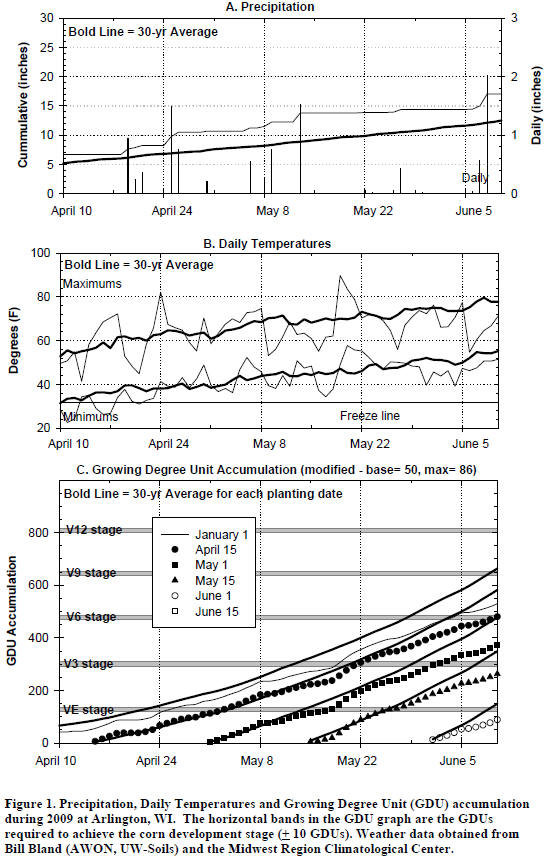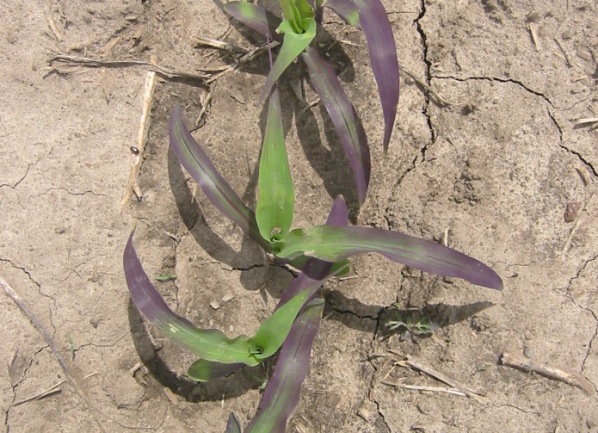June 10, 2009
Field Crops 28.42 - 65
Cool Weather and Purple Corn
Joe Lauer, Corn Agronomist
Many growers have been reporting purple corn plants in their fields this year. The
last 20 days have been cool and Growing Degree Units have started to lag behind
normal (Figure 1). In a planting date study located at Arlington, Pioneer
35F40 have been turning purple shortly after emergence for planting date
of April 10, May 4, and May15 (Figure 2). Plants develop normally but remain purple for about
10-14 days, and then turn green around V4. Digging up some plants, I found 3 to 5 healthy nodal
roots and vigorous root growth. Purpling and other nutrient deficiency symptoms
are often seen around V3-4 as the seminal and radical root systems give way to the
nodal roots, which eventually become the dominant root system for corn.
Purpling in corn is caused by a pigment called anthocyanin. The pigments anthocyanin,
carotene, and chlorophyll are all found in the leaves of corn at all times, except
when the plant dies in the fall. Chlorophyll absorbs red and blue light from sunlight
that falls on leaves and the light reflected is green. Carotene absorbs blue-green
and blue light and the light reflected is yellow. Anthocyanins absorb blue, blue-green,
and green light and the light reflected is red/purple.
These pigments are always present in corn leaves and absorb different wavelengths
of sunlight converting carbon and water to carbohydrates and oxygen through the
process of photosynthesis.
The molecules of chlorophyll are large and are attached to membranes of disc-like
structures, called chloroplasts, inside cells. Chloroplasts are the site of photosynthesis,
the process in which light energy is converted to chemical energy. Chlorophyll is
not a very stable compound, bright sunlight decomposes it, so plants continuously
make it. To produce chlorophyll weather must be sunny and and warm.
Carotene is found in cell chloroplasts and functions by absorbing energy from sunlight
and transferring it to chlorophyll which uses the energy in photosynthesis. Carotene
is a much more stable than chlorophyll and persists in leaves even when chlorophyll
disappears.
Anthocyanins are not attached to cell membranes, but are dissolved in cell sap.
The color produced by these pigments is sensitive to the pH of the cell sap. Anthocyanins
are formed by a reaction between sugars and certain proteins in cell sap. This reaction
requires light and does not occur until the concentration of sugar in the sap is
quite high.
Often purpling in corn is caused by plant stresses that reduce or inhibit
uptake of phosphorous. These stresses include low soil P; restricted root growth
through cool, wet soils, compaction
layers, planter issues involving side-wall compaction; and herbicide injury and . These will likely influence
yield.
Another cause for purpling of leaves is genetic and is related to the process described above. Some hybrids
(and Brands) are more notorious for purpling than others. Purple plants eventually
grow out of this condition and resume normal growth and development as conditions
warm. In fact in this study, plants established on the earlier planting dates
of April 10 and
May 4 are now green and normal in appearance and their is little indication
of yield impact.


Figure 2. Corn (Pioneer 35F40) planted May 15 with purple coloring symptoms. Photo
by Thierno Diallo, UW Corn Agronomy project taken on June 10.